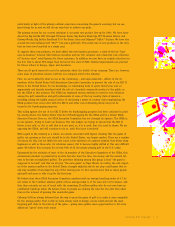Callaway 2000 Annual Report Download - page 21
Download and view the complete annual report
Please find page 21 of the 2000 Callaway annual report below. You can navigate through the pages in the report by either clicking on the pages listed below, or by using the keyword search tool below to find specific information within the annual report.
Callaway Golf Company | 21
fourth quarter of 1998, and an increase in sales of metal woods.
However, cost of goods sold was unfavorably affected by price
reductions and the sales of non-current products through the
Company’s managed close-out program and an increase in distrib-
ution costs associated with the Company’s foreign subsidiaries.
Selling expenses decreased to $128.6 million in 1999 from
$143.7 million in the prior year. As a percentage of net sales,
selling expenses decreased to 18% from 20%. These amounts
reflect the reclassification of shipping revenue and expense,
which were previously recorded in “selling” expense. The effect
of this reclassification reduced selling expense by $3.3 million in
1999 and 1998. The decrease in selling expense is primarily
attributable to planned reductions in advertising, pro tour and
other promotional expenses, partially offset by an increase in
employee compensation.
General and administrative expenses decreased to $92.5 mil-
lion in 1999 from $98.0 million in 1998, or 13% and 14% of net
sales, respectively. This decrease is largely due to decreases in
consulting, bad debt expense and supplies expense, as well as a
decrease in building-related costs associated with the Company’s
1998 restructuring program. These amounts were partially offset
by increases in costs associated with the ramp-up of the
Company’s golf ball operations and increased depreciation and
amortization expense related to the Company’s foreign operations.
Research and development expenses decreased to $34.0 million
(5% of net sales) in 1999 from $36.8 million (5% of net sales) in
1998. This decrease was primarily the result of the shut-down of
the Company’s prototype foundry and a decrease in consulting
fees, partially offset by increases in employee compensation and
component prototype costs.
Restructuring income primarily relates to the reversal of a
restructuring reserve recorded in 1998 for a lease obligation in
New York City that was subsequently assigned to a third party. See
Note 14 to the Consolidated Financial Statements for a discussion
of this and other restructuring transactions.
Sumitomo Rubber Industries Ltd. (“Sumitomo”) transition
costs represent payments for non-current product which were
associated with the transition of the distribution of Callaway
Golf ® products from Sumitomo to the Company. See Note 16 to
the Consolidated Financial Statements for a discussion of this
transaction.
Interest and other income increased to $9.2 million from $3.9
million for the year ended December 31, 1999 as compared with
the prior year. This increase is primarily attributable to an
increase in interest income resulting from higher average cash and
deferred compensation investment balances during 1999 as com-
pared with 1998, an increase in royalty income and an increase in
other income due to the receipt of insurance proceeds related to
the Company’s deferred compensation plan.
Interest expense increased to $3.6 million in 1999 from $2.7
million in 1998. This increase is largely related to interest on the
Company’s interim finance agreement for pre-lease financing
advances for the acquisition and installation costs of machinery
and equipment. Also contributing to the increase was an increase
in interest expense related to the Company’s line of credit and
accounts receivable securitization facilities associated with higher
interest and yield rates and related fees.
During 1999, the Company recorded a tax provision of $30.2
million and recognized a decrease in deferred taxes of $9.6 mil-
lion. During 1999, the Company realized tax benefits of $2.4 mil-
lion related to the exercise of stock options, $1.4 million related
to non-taxable income from insurance proceeds related to the
Company’s deferred compensation plan and $1.0 million related to
the reorganization of a foreign subsidiary.
LIQUIDITY AND CAPITAL RESOURCES
At December 31, 2000, cash and cash equivalents decreased to
$102.6 million from $112.6 million at December 31, 1999. The
decrease is the result of cash used in financing activities of $70.5
million and cash used in investing activities of $28.6 million,
partially offset by cash provided by operating activities of $91.1
million. Cash flows used in financing activities are primarily
attributable to the acquisition of 4.8 million shares of the
Company’s Common Stock and to dividends paid, partially offset
by cash flows from the issuance of Common Stock in connection
with stock option exercises. Cash flows used in investing activi-
ties are primarily attributable to capital expenditures. Cash flows
provided by operating activities reflect increases in accounts
payable and accrued expenses, accrued warranty expense and
income taxes payable, partially offset by increases in accounts
receivable and inventory.
The Company’s principal source of liquidity, both on a short-
term and long-term basis, has been cash flow provided by opera-
tions and the Company’s credit facilities. The Company currently
expects this trend to continue. The Company has a revolving
credit facility for up to $120.0 million (the “Amended Credit
Agreement”) and an $80.0 million accounts receivable securitiza-
tion facility (the “Accounts Receivable Facility”) (see Notes 4
and 5 to the Consolidated Financial Statements). During 2000, the
Company did not utilize either its Accounts Receivable Facility or
























